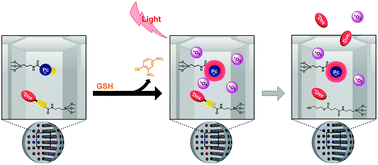Glutathione- and light-controlled generation of singlet oxygen for triggering drug release in mesoporous silica nanoparticles†
Abstract
A combined stimulus-responsive photosensitiser and drug release system based on mesoporous silica nanoparticles was prepared. This nanoplatform encapsulated molecules of zinc(II) phthalocyanine substituted with a glutathione-cleavable 2,4-dinitrobenzenesulfonate quencher and doxorubicin linked via a singlet-oxygen-cleavable 9,10-dialkoxyanthracene linker. In the presence of glutathione (in mM range) and upon irradiation (λ > 610 nm), the phthalocyanine units were activated by detaching from the quenching component to emit fluorescence and generate singlet oxygen. The latter subsequently cleaved the 9,10-dialkoxyanthracene linker to trigger the release of a doxorubicin derivative. The glutathione- and light-controlled activation and drug-release processes on this nanoplatform were demonstrated in phosphate buffered saline. The activation in fluorescence emission by intracellular thiols was also shown inside HepG2 human hepatocellular carcinoma cells. Upon irradiation, the nanosystem exhibited high cytotoxicity due to the photodynamic effect of the activated phthalocyanine units, but the cytotoxic effect of the released Dox moieties was not notable probably due to their reduced cytotoxicity as a result of the pendant substituent and the low drug loading in the nanoparticles.



 Please wait while we load your content...
Please wait while we load your content...